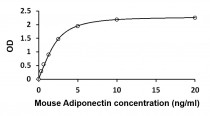ARG82678
Mouse Adiponectin ELISA Kit
Mouse Adiponectin ELISA Kit for ELISA and Mouse
Component
| Cat No | Component Name | Package | Temp |
|---|---|---|---|
| ARG82678-001 | Antibody-coated microplate | 8 X 12 strips | 4°C. Unused strips should be sealed tightly in the air-tight pouch. |
| ARG82678-002 | Standard | 2 X 20 ng/vial | 4°C |
| ARG82678-003 | Standard/Sample diluent | 30 ml (Ready to use) | 4°C |
| ARG82678-004 | Antibody conjugate concentrate (100X) | 1 vial (100 µl) | 4°C |
| ARG82678-005 | Antibody diluent buffer | 12 ml (Ready to use) | 4°C |
| ARG82678-006 | HRP-Streptavidin concentrate (100X) | 1 vial (100 µl) | 4°C |
| ARG82678-007 | HRP-Streptavidin diluent buffer | 12 ml (Ready to use) | 4°C |
| ARG82678-008 | 25X Wash buffer | 20 ml | 4°C |
| ARG82678-009 | TMB substrate | 10 ml (Ready to use) | 4°C (Protect from light) |
| ARG82678-010 | STOP solution | 10 ml (Ready to use) | 4°C |
| ARG82678-011 | Plate sealer | 4 strips | Room temperature |
Overview
| Product Description | ARG82678 Mouse Adiponectin ELISA Kit is an Enzyme Immunoassay kit for the quantification of Mouse Adiponectin in Serum, plasma (EDTA, heparin), cell culture supernatant and urine. |
|---|---|
| Tested Reactivity | Ms |
| Tested Application | ELISA |
| Specificity | There is no detectable cross-reactivity with other relevant proteins. |
| Target Name | Adiponectin |
| Conjugation | HRP |
| Conjugation Note | Substrate: TMB and read at 450 nm. |
| Sensitivity | 0.16 ng/ml |
| Sample Type | Serum, plasma (EDTA, heparin), cell culture supernatant and urine. |
| Standard Range | 0.312 - 20 ng/ml |
| Sample Volume | 100 µl |
| Precision | Intra-Assay CV: 5.6% Inter-Assay CV: 6.4% |
| Alternate Names | Adipose most abundant gene transcript 1 protein; ADPN; APM-1; Gelatin-binding protein; APM1; ACDC; Adiponectin; apM-1; ACRP30; ADIPQTL1; GBP28; 30 kDa adipocyte complement-related protein; Adipocyte, C1q and collagen domain-containing protein; Adipocyte complement-related 30 kDa protein |
Application Instructions
| Assay Time | ~ 5 hours |
|---|
Properties
| Form | 96 well |
|---|---|
| Storage Instruction | Store the kit at 2-8°C. Keep microplate wells sealed in a dry bag with desiccants. Do not expose test reagents to heat, sun or strong light during storage and usage. Please refer to the product user manual for detail temperatures of the components. |
| Note | For laboratory research only, not for drug, diagnostic or other use. |
Bioinformation
| Database Links | |
|---|---|
| Gene Symbol | ADIPOQ |
| Gene Full Name | adiponectin, C1Q and collagen domain containing |
| Background | This gene is expressed in adipose tissue exclusively. It encodes a protein with similarity to collagens X and VIII and complement factor C1q. The encoded protein circulates in the plasma and is involved with metabolic and hormonal processes. Mutations in this gene are associated with adiponectin deficiency. Multiple alternatively spliced variants, encoding the same protein, have been identified. [provided by RefSeq, Apr 2010] |
| Function | Important adipokine involved in the control of fat metabolism and insulin sensitivity, with direct anti-diabetic, anti-atherogenic and anti-inflammatory activities. Stimulates AMPK phosphorylation and activation in the liver and the skeletal muscle, enhancing glucose utilization and fatty-acid combustion. Antagonizes TNF-alpha by negatively regulating its expression in various tissues such as liver and macrophages, and also by counteracting its effects. Inhibits endothelial NF-kappa-B signaling through a cAMP-dependent pathway. May play a role in cell growth, angiogenesis and tissue remodeling by binding and sequestering various growth factors with distinct binding affinities, depending on the type of complex, LMW, MMW or HMW. [UniProt] |
| Highlight | Related products: Adiponectin antibodies; Adiponectin ELISA Kits; Adiponectin Duos / Panels; New ELISA data calculation tool: Simplify the ELISA analysis by GainData |
| PTM | Hydroxylated Lys-33 was not identified in PubMed:16497731, probably due to poor representation of the N-terminal peptide in mass fingerprinting. HMW complexes are more extensively glycosylated than smaller oligomers. Hydroxylation and glycosylation of the lysine residues within the collagene-like domain of adiponectin seem to be critically involved in regulating the formation and/or secretion of HMW complexes and consequently contribute to the insulin-sensitizing activity of adiponectin in hepatocytes (By similarity). O-glycosylated. Not N-glycosylated. O-linked glycans on hydroxylysines consist of Glc-Gal disaccharides bound to the oxygen atom of post-translationally added hydroxyl groups. Sialylated to varying degrees depending on tissue. Thr-22 appears to be the major site of sialylation. Higher sialylation found in SGBS adipocytes than in HEK fibroblasts. Sialylation is not required neither for heterodimerization nor for secretion. Not sialylated on the glycosylated hydroxylysines. Desialylated forms are rapidly cleared from the circulation. [UniProt] |
Images (1) Click the Picture to Zoom In
| Title | Download Link |
|---|---|
| ARG82678 Mouse Adiponectin ELISA Kit User manual |
 Download Download
|






